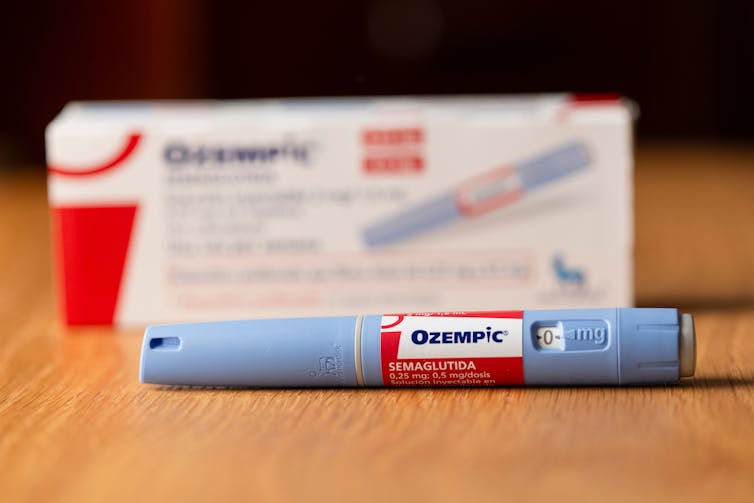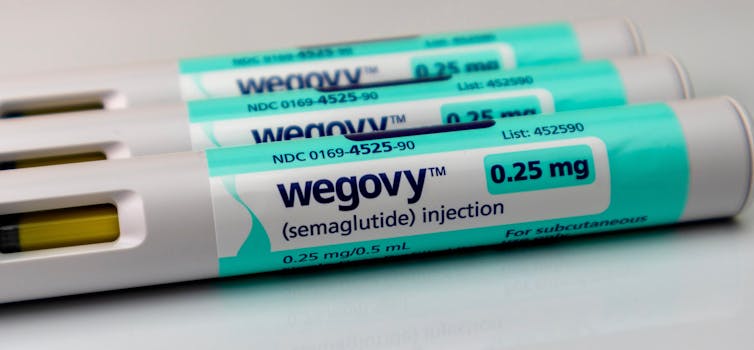
The craze for new drugs in the GLP-1 (Glucagon-like peptide 1) and GIP (Gastric inhibitory polypeptide) analogue class, better known under the trade names Ozempic and Wegovy, is remarkable, but it’s not totally unprecedented in the history of pharmaceutical blockbusters.
The volume of prescriptions and the budget allocated to them by public health insurance schemes are exploding, as are the profits of the companies that manufacture them.
Part of the popularity of these drugs owes to social networks, but these are not always the best source for health information. When it comes to the subject of weight loss, both fantasy and prejudice come into play. This works to the detriment of everyone’s well-being, but particularly those who are already stigmatized.
As specialists in the philosophy of medicine (Université de Montréal), nutrition and food science (Université Laval), the sociology of medication (Université de Montréal) and endocrinology (Institut de recherches cliniques de Montréal), we feel it’s necessary to step back and take stock of both the promises and the limitations of these new treatments.
The best of both worlds
GLP-1/GIP analogues were originally developed to regulate glycemia (blood sugar levels) in people with Type 2 diabetes, thereby preventing the complications associated with this disease. When studies were carried out to assess their safety and efficacy, it was discovered that these drugs also led to weight loss. This prompted new research which showed that at higher doses, the drugs could lead to very significant weight loss, from 15 to 25 per cent of the starting weight.

The mode of action of these drugs on blood sugar regulation is clear: they simulate incretin hormones which, in turn, increase insulin secretion. Weight loss, on the other hand, was only explained after the fact: in addition to the pancreas, these molecules also act on the brain by regulating the sensation of satiety and, indirectly, on the stomach by slowing gastric emptying. These two combined effects reduce appetite and lead to weight reduction.

This is how a new use for the drug appeared, at which point the company Novo Nordisk began marketing the same drug under two different names: Ozempic to treat Type 2 diabetes, and Wegovy to manage obesity.
A new era
GLP-1/GIP analogues are a welcome therapeutic breakthrough at a time when the prevalence of Type 2 diabetes and obesity is exploding and affecting people younger and younger.
These diseases particularly affect women, members of racialized groups and socio-economically disadvantaged populations. The physical and mental suffering these cause and the costs associated with treating them are both considerable. So the arrival of new weapons in the therapeutic arsenal is a source of hope.
Draconian changes in lifestyle are certainly effective. But they are very difficult to implement and maintain over time for reasons that go beyond the individual sphere; on the one hand, genetic predisposition plays a major role in the development of Type 2 diabetes and obesity; on the other, because these conditions are multifactorial, management of them must be comprehensive to be effective and long lasting: it must combine medical interventions but also nutritional, functional, psycho-social, environmental and even institutional interventions.

Support services of this kind do exist, but only in large university hospital centres to which many people do not have access. Nor do many people have easy access to healthy and varied food options, sports facilities or social and psychological support.
Treating the effects but not the causes
To be effective over the long term, GLP-1/GIP analogues must be taken continuously: without drastic lifestyle changes, the weight that was lost is regained within a year of stopping, and glycemic control is compromised once again.
In other words, the drugs treat the effects of Type 2 diabetes and obesity but not their causes. And yet some of these causes are modifiable: for example, according to Statistics Canada, less than half the Canadian population (49.2 per cent for adults; 43.9 per cent for young people and children) achieves the recommended amount of weekly physical activity. According to the same source, food insecurity affects around 14 per cent of the Québec population (22 per cent in Alberta).

Pharmacological treatment, even if it allows an individual to eat less, does not necessarily mean that person will eat better. Similarly, losing weight does not mean one will become more active or healthier. So these new drugs do not cure Type 2 diabetes or obesity. Nor do they prevent these diseases from developing, although they do help to limit the many complications to which they give rise.
Prescribe and treat
A drug such as Mounjaro is as effective at weight loss as bariatric surgery. Much easier to administer and much less risky, it could be a real game changer in the treatment of obesity. Prescribed directly by family doctors and dispensed in pharmacies, it would also be much more accessible and easier to administer for those who need it.
This raises the question of costs and reimbursement, but not only that: prescribing is not the same as treating. Here, the manufacturers are following the recommendations of the health authorities: this treatment must be preceded by a careful assessment, then management, and above all a close and regular monitoring of diet, physical activity, mental health, and if necessary, socio-economic assistance.
This requires not only time that GPs do not have, but also co-ordination with other players in the health-care network. The problem is not whether the treatment will be effective, but what can happen if it is. Losing 25 per cent of your body weight in just a few months has serious consequences, which are not always beneficial: it involves a loss of body fat, but also of muscle mass, which is associated with intense fatigue. Nor should we underestimate the challenge of adapting physically and psychologically to a body transformation of this scale. Losing weight doesn’t solve everything, and expectations must remain realistic.
What lessons can we learn?
The clinical effectiveness of GLP-1/GIP analogues in reducing the complications associated with Type 2 diabetes and obesity is indisputable. However, these drugs are not suitable for everyone, and they are certainly not miracle cures that will make it possible for one to regain health without making any changes to lifestyle or environment.
We must bear in mind that their success, both commercial and medical, is also the result of a failure: that of our societies to prevent these diseases, to promote healthy lifestyles and to develop environments conducive to the health of all.
Aude Bandini has received funding from the Arts and Humanities Research Council.
Jean-Philippe Drouin-Chartier has received research funding from Dairy Farmers of Canada and the Weston Family Foundation.
Pierre-Marie David has received funding from the Social Sciences and Humanities Research Council.
Rémi Rabasa-Lhoret has received funding from the following research funds: Diabetes Canada, Astra-Zeneca, E Lilly, Cystic Fibrosis Canada, CIHR, FFRD, Janssen, JDRF, Merck, NIH, Novo-Nordisk, Société Francophone du Diabète. Advisory committees/consultant: Abbott, Astra-Zeneca, Bayer, Boehringer I, Dexcom, Eli Lilly, GlaxoSmithKline Inc, HSL therapeutics, INESSS, Insulet, Janssen, Medtronic, Merck, Novo-Nordisk, Pfizer, Sanofi-Aventis, YPSOMED Canada. Conference fees: Abbott, Astra-Zeneca, Boehringer I, CPD Network, Dexcom, E Lilly, Janssen, Medtronic, Merck, Novo-Nordisk, Sanofi-Aventis, Tandem, Vertex Pharmaceutical. Donation of equipment: E Lilly, Medtronic. Unrestricted funds (educational activities): Abbott, Dexcom, Eli Lilly, Medtronic, Merck, Novo Nordisk, Sanofi. Patents: beta cell mass and function biomarkers, catheter port duration. Amounts received following the sale of an invention: Eli Lilly (artificial pancreas).
This article was originally published on The Conversation. Read the original article.







